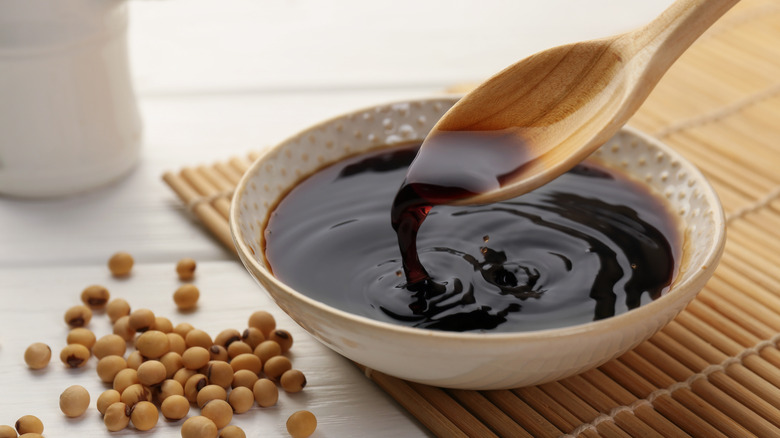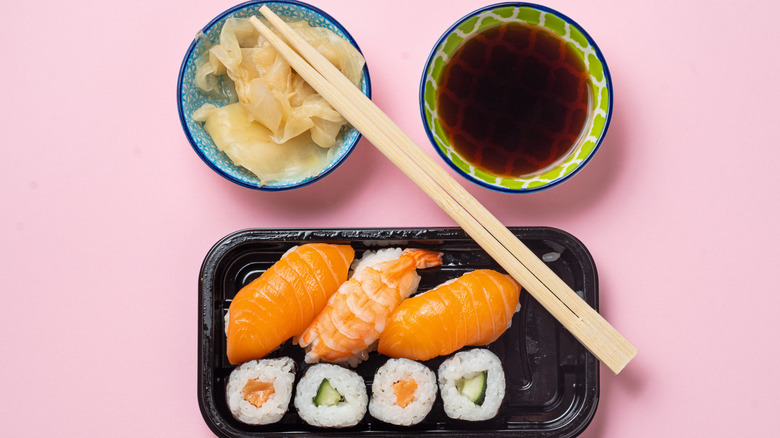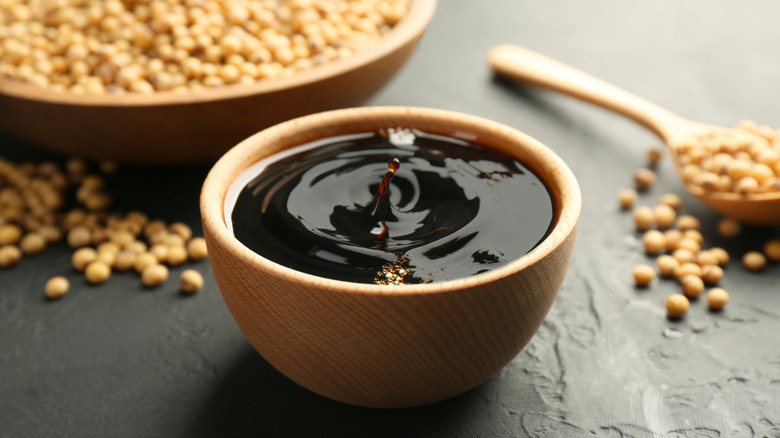What's The Difference Between Dark Soy Sauce And Regular Soy Sauce?
We may receive a commission on purchases made from links.
Even though soy sauce originated thousands of years ago in ancient China, it wasn't until the 17th century that it made its way into the Western world when the famous English philosopher John Locke first mentioned it in one of his journals. By uniting the full spectrum of taste – from umami and sweet to salty, bitter, and tangy– this beloved condiment has since completely taken over the globe, making it hard to imagine devouring a bowl of perfectly cooked vermicelli noodles or a tuna sushi roll without it.
The hype around soy sauce has prompted tons of different versions to emerge on the market over the years. Hence, one of these varieties, dark soy sauce — also known as Koikuchi Shoyu in its native country – has recently been getting a lot of attention, even though it already makes up about 80% of all the soy sauce consumed in Japan. But what makes it so different from regular, "light" soy sauce? And speaking of, what is soy sauce made from anyway?
While the two types are made of the same basic ingredients — soybeans, wheat, salt, and usually Aspergilluss oryzae yeast as a fermenting agent — it's the details that set them apart. Beyond the difference that's already hinted in the name, the fermentation and aging process, flavor, thickness, and how the two are ultimately utilized in culinary practices make them each their own.
What makes light soy sauce stand out?
Sharp and salty with subtle caramel notes, light soy sauce is made by fermenting moromi mash — a freshly brewed, unfermented mix — for several months. Once the fermentation is complete, the mixture is pressed to extract the liquid, which is then left to rest for another couple of months so that the sauce can develop its signature flavor. (A far cry from the world's most expensive soy sauce, which is aged 38 years.)
Thin, yet rich and nutty, with its flavor characteristics developed due to the addition of wheat in the brewing process, light soy sauce boasts a pungent, complex aroma and golden-brown tones. Some sauce varieties even offer hints of roasted grains, aged wood, and a subtle touch of alcohol from the fermentation process.
In addition, due to its high sodium content (which can be over 300 milligrams per teaspoon), light soy sauce is ideal for sauces and meat marinades, as the salt helps break down and tenderize the meat. It also makes its way into a wide number of dishes, especially stir-fries and soup broths, to which it adds depth and complexity. An essential addition to noodle dishes, it's also used as a dipping sauce for dumplings and sushi.
How is dark soy sauce different?
Unlike its lighter counterpart, dark soy sauce boasts an intense umami flavor and an unmistakable aroma. This is largely because of its extended fermentation and aging process, which leads to up to 90% soybean and wheat protein breakdown over time. In turn, this naturally deepens not only its taste but also gives it its signature color and viscosity, even though both types follow a similar 1:1 wheat-to-soybean ratio.
Dark soy sauce boasts a tangy edge and is less salty than regular soy sauce, giving it a bold flavor that's both bitter and sweet at the same time. It is used both as a condiment and a cooking ingredient, as it delivers umami and saltiness to bland dishes. It also shines in teriyaki (one of Seattle's signature dishes) as it gives it more depth. Dark soy sauce is ideal for braising and marinades and even works beautifully in gravies, stir-fries, and sauces. When used as a dipping sauce, it's often paired with wasabi or karashi — Japanese spicy mustards — for an extra kick of heat.
If this left you wondering where to get it, keep in mind that it might already be on your shelf. While "dark soy sauce" may not always be indicated on labels in U.S. supermarkets, you might be surprised to learn that many popular picks like the Kikkoman All-Purpose Seasoning Naturally Brewed Soy Sauce, are just low-profile versions of dark soy sauce.


